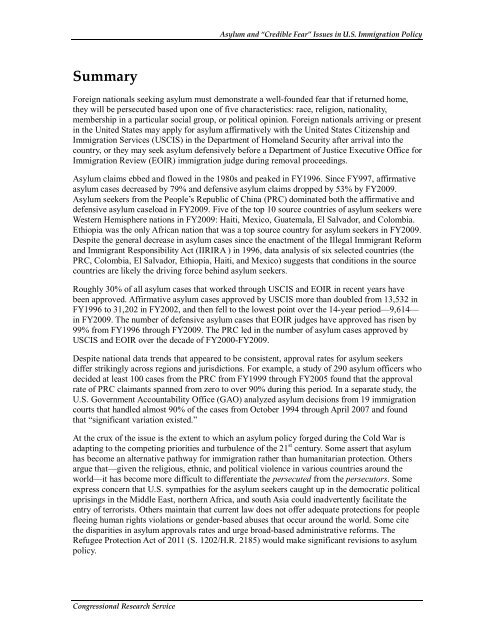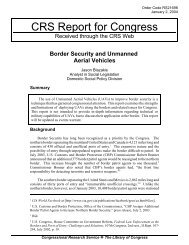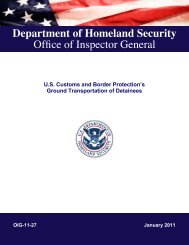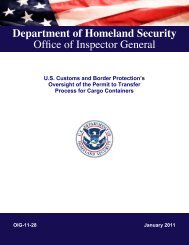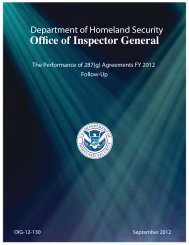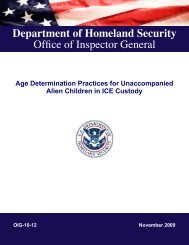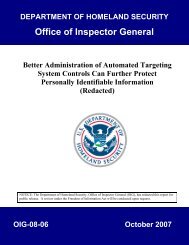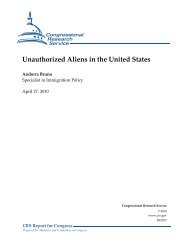Asylum and "Credible Fear" Issues in U.S. Immigration Policy
Asylum and "Credible Fear" Issues in U.S. Immigration Policy
Asylum and "Credible Fear" Issues in U.S. Immigration Policy
You also want an ePaper? Increase the reach of your titles
YUMPU automatically turns print PDFs into web optimized ePapers that Google loves.
<strong>Asylum</strong> <strong>and</strong> “<strong>Credible</strong> Fear” <strong>Issues</strong> <strong>in</strong> U.S. <strong>Immigration</strong> <strong>Policy</strong>SummaryForeign nationals seek<strong>in</strong>g asylum must demonstrate a well-founded fear that if returned home,they will be persecuted based upon one of five characteristics: race, religion, nationality,membership <strong>in</strong> a particular social group, or political op<strong>in</strong>ion. Foreign nationals arriv<strong>in</strong>g or present<strong>in</strong> the United States may apply for asylum affirmatively with the United States Citizenship <strong>and</strong><strong>Immigration</strong> Services (USCIS) <strong>in</strong> the Department of Homel<strong>and</strong> Security after arrival <strong>in</strong>to thecountry, or they may seek asylum defensively before a Department of Justice Executive Office for<strong>Immigration</strong> Review (EOIR) immigration judge dur<strong>in</strong>g removal proceed<strong>in</strong>gs.<strong>Asylum</strong> claims ebbed <strong>and</strong> flowed <strong>in</strong> the 1980s <strong>and</strong> peaked <strong>in</strong> FY1996. S<strong>in</strong>ce FY997, affirmativeasylum cases decreased by 79% <strong>and</strong> defensive asylum claims dropped by 53% by FY2009.<strong>Asylum</strong> seekers from the People’s Republic of Ch<strong>in</strong>a (PRC) dom<strong>in</strong>ated both the affirmative <strong>and</strong>defensive asylum caseload <strong>in</strong> FY2009. Five of the top 10 source countries of asylum seekers wereWestern Hemisphere nations <strong>in</strong> FY2009: Haiti, Mexico, Guatemala, El Salvador, <strong>and</strong> Colombia.Ethiopia was the only African nation that was a top source country for asylum seekers <strong>in</strong> FY2009.Despite the general decrease <strong>in</strong> asylum cases s<strong>in</strong>ce the enactment of the Illegal Immigrant Reform<strong>and</strong> Immigrant Responsibility Act (IIRIRA ) <strong>in</strong> 1996, data analysis of six selected countries (thePRC, Colombia, El Salvador, Ethiopia, Haiti, <strong>and</strong> Mexico) suggests that conditions <strong>in</strong> the sourcecountries are likely the driv<strong>in</strong>g force beh<strong>in</strong>d asylum seekers.Roughly 30% of all asylum cases that worked through USCIS <strong>and</strong> EOIR <strong>in</strong> recent years havebeen approved. Affirmative asylum cases approved by USCIS more than doubled from 13,532 <strong>in</strong>FY1996 to 31,202 <strong>in</strong> FY2002, <strong>and</strong> then fell to the lowest po<strong>in</strong>t over the 14-year period—9,614—<strong>in</strong> FY2009. The number of defensive asylum cases that EOIR judges have approved has risen by99% from FY1996 through FY2009. The PRC led <strong>in</strong> the number of asylum cases approved byUSCIS <strong>and</strong> EOIR over the decade of FY2000-FY2009.Despite national data trends that appeared to be consistent, approval rates for asylum seekersdiffer strik<strong>in</strong>gly across regions <strong>and</strong> jurisdictions. For example, a study of 290 asylum officers whodecided at least 100 cases from the PRC from FY1999 through FY2005 found that the approvalrate of PRC claimants spanned from zero to over 90% dur<strong>in</strong>g this period. In a separate study, theU.S. Government Accountability Office (GAO) analyzed asylum decisions from 19 immigrationcourts that h<strong>and</strong>led almost 90% of the cases from October 1994 through April 2007 <strong>and</strong> foundthat “significant variation existed.”At the crux of the issue is the extent to which an asylum policy forged dur<strong>in</strong>g the Cold War isadapt<strong>in</strong>g to the compet<strong>in</strong>g priorities <strong>and</strong> turbulence of the 21 st century. Some assert that asylumhas become an alternative pathway for immigration rather than humanitarian protection. Othersargue that—given the religious, ethnic, <strong>and</strong> political violence <strong>in</strong> various countries around theworld—it has become more difficult to differentiate the persecuted from the persecutors. Someexpress concern that U.S. sympathies for the asylum seekers caught up <strong>in</strong> the democratic politicalupris<strong>in</strong>gs <strong>in</strong> the Middle East, northern Africa, <strong>and</strong> south Asia could <strong>in</strong>advertently facilitate theentry of terrorists. Others ma<strong>in</strong>ta<strong>in</strong> that current law does not offer adequate protections for peopleflee<strong>in</strong>g human rights violations or gender-based abuses that occur around the world. Some citethe disparities <strong>in</strong> asylum approvals rates <strong>and</strong> urge broad-based adm<strong>in</strong>istrative reforms. TheRefugee Protection Act of 2011 (S. 1202/H.R. 2185) would make significant revisions to asylumpolicy.Congressional Research Service


